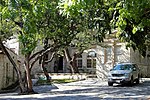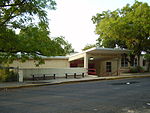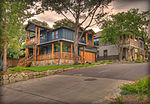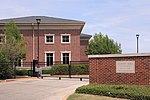Larry Monroe Forever Bridge
Bridges in Austin, TexasCulture of Austin, TexasLandmarks in Austin, TexasMonuments and memorials in TexasPublic art in Austin, Texas ... and 2 more
Streets in Austin, TexasTourist attractions in Austin, Texas

Larry Monroe Forever Bridge is a bridge mural and memorial to Austin broadcaster and musical scholar Larry Monroe. The bridge's two low walls are decorated with mosaic tiles relating to Monroe and the music he played on Austin radio for more than 30 years. Artist Stefanie Distefano designed and directed the project. The bridge is located on East Side Drive as it crosses Blunn Creek between Stacy Park and Little Stacy Park in the Travis Heights neighborhood in South Austin, Texas.
Excerpt from the Wikipedia article Larry Monroe Forever Bridge (License: CC BY-SA 3.0, Authors, Images).Larry Monroe Forever Bridge
East Side Drive, Austin
Geographical coordinates (GPS) Address Nearby Places Show on map
Geographical coordinates (GPS)
| Latitude | Longitude |
|---|---|
| N 30.24754 ° | E -97.744402 ° |
Address
East Side Drive 1521
78704 Austin
Texas, United States
Open on Google Maps










